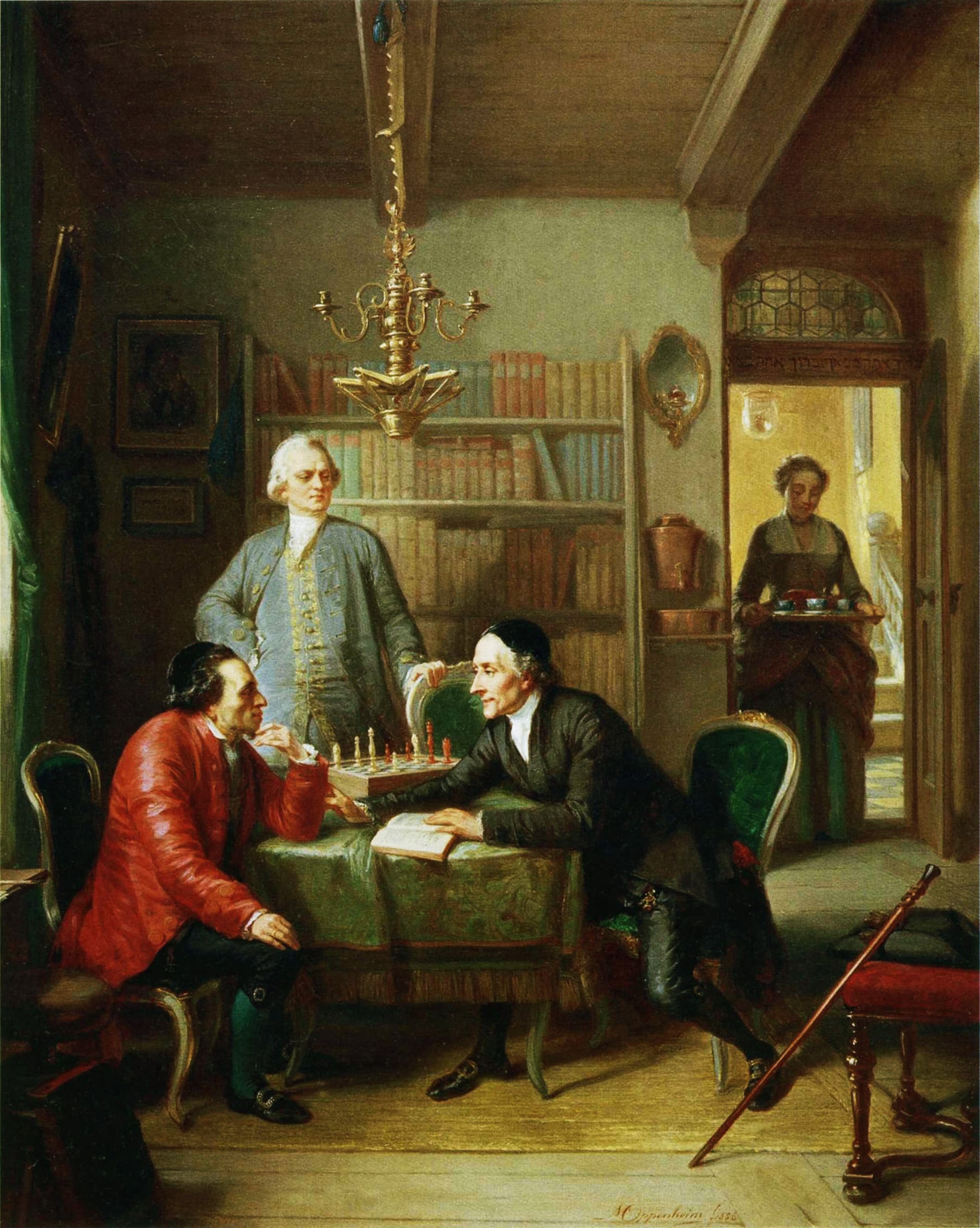Lavater and Lessing Visit Moses Mendelssohn. Portrays an imagined meeting among Mendelsohn (1729-1786) and Gotthold Ephraim Lessing (1729-1781), and the Swiss theologian Johann Kaspar Lavater (1741-1801), at the residence of Moses Mendelssohn located at Spandauerstraße 68, Alt Berlin. Mendelssohn (on the left), wearing a red coat, and seated at a chess table in his library with Lavater. Lessing stands at the center behind the two. The scene refers to two foundational moments in the history of German-Jewish cultural interaction. The actual meetings between Mendelssohn and Lavater, which took place in 1763-64, were followed by the failed attempt on the part of the theologian to convince Mendelssohn to embrace Christianity. The well-known friendship between Mendelssohn and Lessing, one of the high points of the haskalah, or “Jewish Enlightenment,” came to be considered a paradigm of the possibility of a harmonious cohabitation between Germans and Jews. Painted in 1856 by Moritz Daniel Oppenheim (1800–1882), German painter. Collection: Judah L. Magnes Museum / The Magnes Collection of Jewish Art and Life, Californien. (CC BY-NC-SA 3.0). Source: Wikimedia Commons.
Forside 1729 Lavater and Lessing Visit Moses Mendelssohn. Portrays an imagined meeting among Mendelsohn (1729-1786) and Gotthold Ephraim Lessing (1729-1781), and the Swiss theologian Johann Kaspar Lavater (1741-1801), at the residence of Moses Mendelssohn located at Spandauerstraße 68, Alt Berlin. Mendelssohn (on the left), wearing a red coat, and seated at a chess table in his library with Lavater. Lessing stands at the center behind the two. The scene refers to two foundational moments in the history of German-Jewish cultural interaction. The actual meetings between Mendelssohn and Lavater, which took place in 1763-64, were followed by the failed attempt on the part of the theologian to convince Mendelssohn to embrace Christianity. The well-known friendship between Mendelssohn and Lessing, one of the high points of the haskalah, or “Jewish Enlightenment,” came to be considered a paradigm of the possibility of a harmonious cohabitation between Germans and Jews. Painted in 1856 by Moritz Daniel Oppenheim (1800–1882), German painter. Collection: Judah L. Magnes Museum / The Magnes Collection of Jewish Art and Life, Californien. (CC BY-NC-SA 3.0).
Lavater and Lessing Visit Moses Mendelssohn. Portrays an imagined meeting among Mendelsohn (1729-1786) and Gotthold Ephraim Lessing (1729-1781), and the Swiss theologian Johann Kaspar Lavater (1741-1801), at the residence of Moses Mendelssohn located at Spandauerstraße 68, Alt Berlin. Mendelssohn (on the left), wearing a red coat, and seated at a chess table in his library with Lavater. Lessing stands at the center behind the two. The scene refers to two foundational moments in the history of German-Jewish cultural interaction. The actual meetings between Mendelssohn and Lavater, which took place in 1763-64, were followed by the failed attempt on the part of the theologian to convince Mendelssohn to embrace Christianity. The well-known friendship between Mendelssohn and Lessing, one of the high points of the haskalah, or “Jewish Enlightenment,” came to be considered a paradigm of the possibility of a harmonious cohabitation between Germans and Jews. Painted in 1856 by Moritz Daniel Oppenheim (1800–1882), German painter. Collection: Judah L. Magnes Museum / The Magnes Collection of Jewish Art and Life, Californien. (CC BY-NC-SA 3.0).


























